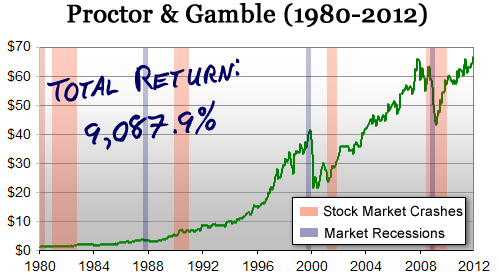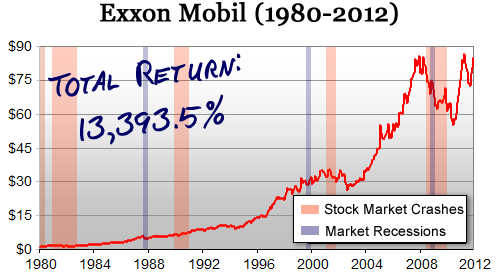Why Smart Investors Are Pouring Trillions into This Type Of Stock
For decades, analysts have heralded small-cap stocks as the real growers in the stock market. And they’re right to some extent; a study that tracked stock returns from 1926 to 2008 found that U.S. small caps delivered an annualized return of 16.5% compared to large caps’ annualized return of 12.9%.#-ad_banner-#
But that doesn’t mean investors are dumping their large-cap stocks — big, stable companies like Coca-Cola (NYSE: KO) and Microsoft (Nasdaq: MSFT) — in favor of lesser-known small-cap companies (those that are smaller and presumably faster-growing).
In fact, just looking at the entire U.S. stock mutual fund market as of Sept. 30, 2012, investors held a whopping 75% of all assets ($2.6 trillion) in large-cap equity mutual funds. That dwarfs the 15% ($507 billion) investors held in mid-cap funds and the 10% ($360 billion) held in U.S. small-cap funds.
So why are investors using large caps as the backbone of their portfolios?
Because most of them have learned, sometimes reluctantly, that large companies have something small companies don’t have: deep pockets and stability.
Through recessions, wars and market crashes, large companies have been a proven long-term source of both safety and impressive gains. Just look at how these companies fared over the past 31 years:



Want to know exactly how large companies such as these make solid, long-term investments? It all comes down to three main advantages that large-cap companies have over their smaller company counterparts.
Large-Cap Stocks Advantage #1: Less Long-Term Risk For A Healthy Reward
Most investors have heard of the trade-off between risk and reward. But while most investors are focused solely on the return portion of the equation, they can get blindsided by return’s conjoined twin: risk.
Risk is measured by the standard deviation of returns. Essentially, standard deviation tells us how widely a security’s returns are scattered around its average return. It’s how you measure volatility. Clearly, a fund that is up 40% one year and down 20% the next is more volatile (and thus has a higher standard deviation) than one that gains 12% one year and loses 6% the next.
Recalling the 1926 to 2008 investment study mentioned earlier, small-cap stocks delivered an annual return of 16.5%, beating out large caps’ return of 12.9%. But small caps’ standard deviation was significantly higher — 33% versus large caps’ standard deviation of 20.6%.

In this case, small-cap investors may have been rewarded with an extra 3.6% annual return, but they also took on an extra 12.4% of risk. That’s sort of like driving fast and recklessly around tight corners to get to the store just a few minutes earlier than you would have if you drove safely — it’s dangerous, and the reward may not be worth it. Large-cap stocks offer investors a way to shed some of that excessive risk and still keep most of the healthy returns.
Large-Cap Stocks Advantage #2: Iron Defense During Recessions
It’s been said many times, but it bears repeating: Cash is king. A large-cap company’s cash hoard is a great defense against a stagnant or declining economy. If the company faces headwinds, it can always use its cash reserves to keep operations running until the economy rebounds. It’s a lifeline of staying power and a luxury that most small-cap companies don’t have.
In addition, larger companies are equipped with proven business models, established market exposure and brand-name recognition — qualities that make them more likely to stand the test of time — and deliver excellent returns for investors over the long term.
That explains why large-cap stocks fall far less during market downturns. From 1969 to 1970, small caps tumbled 38% while the large-cap S&P 500 fell just 5%.
And while both large and small caps declined by a similar amount from the recent market peak in May 2008 to the crash’s low in March 2009 (dropping 52.8% vs. 53.5%, respectively), the most elite of the large-cap stocks — the blue chips of the Dow Jones Industrial Average (DJIA) — fell a less painful 39.8%.
Don’t worry, patient investors who held on to their large-cap stocks after the 2008-2009 market crash didn’t have to suffer losses for long — the S&P 500 index (which tracks 500 large-cap stocks) bounced right back and recouped the bulk of its value by April 2010, just over one year later. That’s because large, valuable companies stay valuable to investors even in bad markets.
Large-Cap Stocks Advantage #3: A Stockpile of Resources For Strong Future Growth
Even more important than a defense mechanism, a large company’s cash hoard and other existing capital (plants, property, technology and special equipment) can be its greatest weapons for adaptability and future growth.
Large companies with multibillion-dollar war chests have used their greenbacks and other resources in a number of ways to expand their businesses and keep their shareholders happy. In 2011, for example:
Intel (Nasdaq: INTC) used $10 billion to buy back company shares, increasing its earnings per share (EPS) and strengthening the stock’s value.
Bristol-Myers Squibb (NYSE: BMY) transferred $750 million from cash reserves to pay down debt and decrease default risk. The company has also been using cash to invest in research and development to develop new lines of life-saving drugs — and potentially boost revenues.
Microsoft invested $8.5 billion of its cash to acquire Skype, expanding its already diverse product line, market exposure and potentially top and bottom lines. It also decided to boost its dividend payment by 25%.
What’s behind a dividend payment increase?
A company announcing that it will increase the size of its dividend payment to shareholders signals that management is confident about its future success. After Microsoft’s large dividend raise in 2011, the company essentially promised to pay shareholders a full 29% of all its profits every year. Think about it on a personal basis: Would you promise to commit nearly a third of your income toward an obligation if you didn’t feel confident about your financial success in the future? Probably not.
Consistent dividend raises, stock buybacks, acquisitions and heavy investments in R&D are unique features that mostly only large-cap companies with incredible earnings and strength can provide. And they’re all more reasons why many investors love holding onto large-cap stocks.
Action to Take –> While it’s smart for investors to diversify their investments, large-cap stocks can provide a solid foundation for growth and defense in almost anyone’s retirement portfolio. In our latest research — Top 10 Stocks for 2013 — we’ve uncovered several more large-cap stocks that dominate their markets, pay increasing dividends and repurchase billions in stock. To learn more about these ideas, including several names and ticker symbols, please visit this link.
These excellent qualities make for a solid investment that offers steady double-digit returns without all the gut-wrenching price movements that come with holding small-cap stocks.
This article originally appeared on InvestingAnswers.com:
Why Smart Investors Are Pouring Trillions into This Type Of Stock
